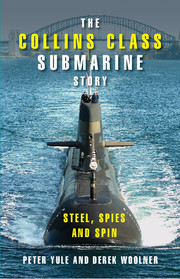Book contents
- Frontmatter
- Contents
- List of key people
- List of acronyms
- Introduction
- Part 1 You Can't Build Submarines in Australia
- 1 ‘The one class of vessel that it is impossible to build in Australia’: Australia's early submarines
- 2 Australia's Oberon class submarines
- 3 The submarine weapons update program and the origins of the new submarine project
- 4 The new submarine project
- 5 ‘We can't build submarines, go away’: Eglo Engineering and the submarine project
- 6 The acts of the apostles
- 7 ‘But how will you judge them?’: the tender evaluation process 1984–85
- 8 Spies, leaks and sackings: from tender evaluation to project definition study
- 9 The project definition study 1985–86
- 10 Debating the laws of physics: picking winners 1987
- Part 2 The Honeymoon Years 1987–92
- Part 3 ‘A Strange Sense of Unease” 1993–98
- Part 4 Resolution
- Notes
- Index
8 - Spies, leaks and sackings: from tender evaluation to project definition study
Published online by Cambridge University Press: 05 September 2013
- Frontmatter
- Contents
- List of key people
- List of acronyms
- Introduction
- Part 1 You Can't Build Submarines in Australia
- 1 ‘The one class of vessel that it is impossible to build in Australia’: Australia's early submarines
- 2 Australia's Oberon class submarines
- 3 The submarine weapons update program and the origins of the new submarine project
- 4 The new submarine project
- 5 ‘We can't build submarines, go away’: Eglo Engineering and the submarine project
- 6 The acts of the apostles
- 7 ‘But how will you judge them?’: the tender evaluation process 1984–85
- 8 Spies, leaks and sackings: from tender evaluation to project definition study
- 9 The project definition study 1985–86
- 10 Debating the laws of physics: picking winners 1987
- Part 2 The Honeymoon Years 1987–92
- Part 3 ‘A Strange Sense of Unease” 1993–98
- Part 4 Resolution
- Notes
- Index
Summary
While the tenders for the submarines came from individual European companies, the contracts for the project definition study were made with consortia formed by Kockums and HDW with Australian industry partners.
The joint venture formed by HDW and Eglo Engineering was not the result of love at first sight. In early 1983 Hans Ohff and John White of Eglo visited all the major submarine builders in Europe. Ohff recalls:
We were received with great courtesy by the Dutch, French, Thyssen and Kockums. The exception was HDW. When we asked for an appointment – with the recommendation from the RAN – we did not receive a reply. A second attempt resulted in ‘an audience’ with Mr Udo Ude (manager acquisition HDW). The interview lasted a short 30 minutes, at best. We explained our capabilities in off-shore oil and gas production platforms, oil refineries, petrochemical plants and shipbuilding (not submarines), and made Ude aware of the important role Australian industry would have in this project. Ude told us that HDW was a submarine builder and would only be interested in the Australian project if at least two boats and subassemblies (packages) would be built in Kiel. We left HDW with the impression that the company was the least desirable partner for Eglo.
HDW was equally unimpressed by its first encounter with Eglo and began talking with large Australian engineering companies such as Transfield and Johns Perry, but found little understanding of what the submarine project would involve. Of the people they talked with, only John Jeremy of Cockatoo Dockyard ‘knew what he was talking about, but Cockatoo was no place to build a submarine’. For some time HDW considered the idea of cooperating with Don Fry of North Queensland Engineers and Agents in Cairns, as the most progressive Australian shipbuilder and also because they were attracted by the conservative government in Queensland ‘for union reasons and for general ease of doing business’. However, after assessing all potential partners, the Germans decided that Eglo, in fact, stood out above the others for its engineering skills, its commitment to the project and the connections it already had with Germany through Hans Ohff and Eglo’s German shareholders.
- Type
- Chapter
- Information
- The Collins Class Submarine StorySteel, Spies and Spin, pp. 76 - 88Publisher: Cambridge University PressPrint publication year: 2008



